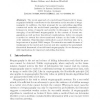Free Online Productivity Tools
i2Speak
i2Symbol
i2OCR
iTex2Img
iWeb2Print
iWeb2Shot
i2Type
iPdf2Split
iPdf2Merge
i2Bopomofo
i2Arabic
i2Style
i2Image
i2PDF
iLatex2Rtf
Sci2ools
ESORICS
2004
Springer
2004
Springer
Breaking Cauchy Model-Based JPEG Steganography with First Order Statistics
Abstract. The recent approach of a model-based framework for steganography fruitfully contributes to the discussion on the security of steganography. In addition, the first proposal for an embedding algorithm constructed under the model-based paradigm reached remarkable performance in terms of capacity and security. In this paper, we review the emerging of model-based steganography in the context of decent steganalysis as well as from theoretical considerations, before we present a method to attack the above-mentioned scheme on the basis of first order statistics. Experimental results show a good detection ratio for a large test set of typical JPEG images. The attack is successful because of weaknesses in the model and does not put into question the generalised theoretical framework of model-based steganography. So we discuss possible implications for improved embedding functions.
ESORICS 2004 | Model-based Framework | Model-based Paradigm | Model-based Steganography | Security Privacy |
| Added | 01 Jul 2010 |
| Updated | 01 Jul 2010 |
| Type | Conference |
| Year | 2004 |
| Where | ESORICS |
| Authors | Rainer Böhme, Andreas Westfeld |
Comments (0)

